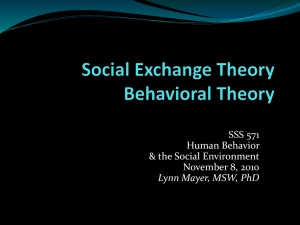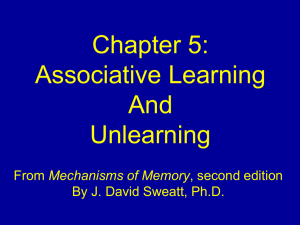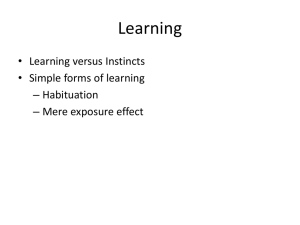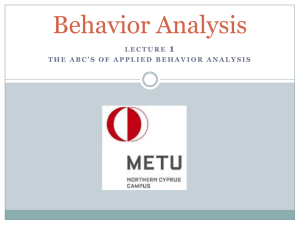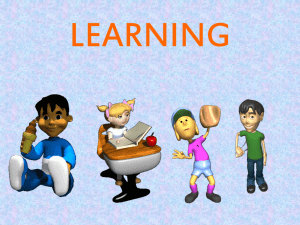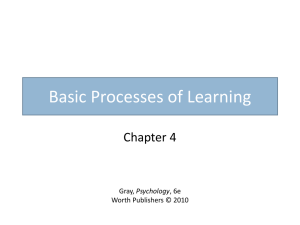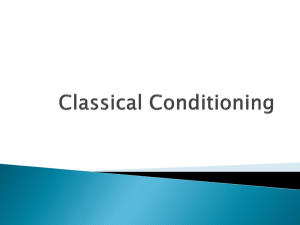Week 9
advertisement
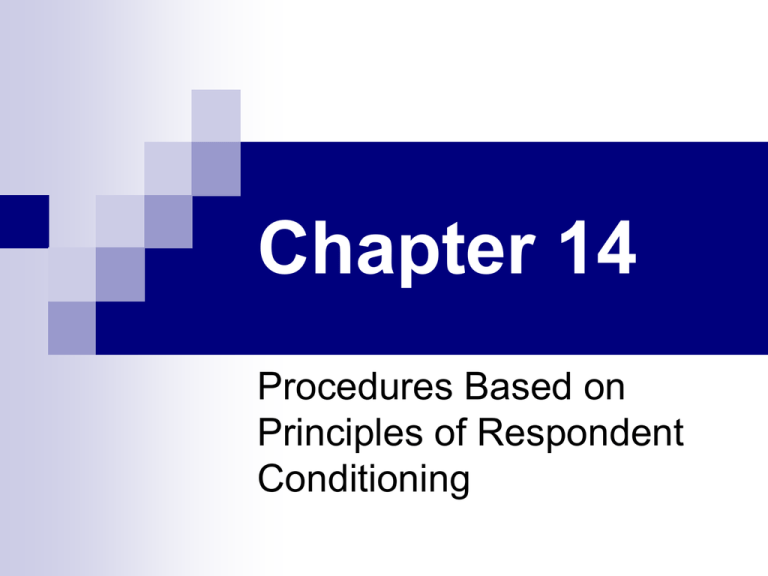
Chapter 14 Procedures Based on Principles of Respondent Conditioning Operant vs. Respondent Behavior Operant behaviors operate on the environment. Respondent behaviors are reflexive behaviors. Principles of Respondent (Classical) Conditioning Unconditioned reflexes: “automatic” stimulus-response relationships. Unconditioned Stimulus and Unconditioned Response: no training required. Respondent Conditioning: pair unconditioned and neutral stimulus to create a conditioned response. The neutral stimulus becomes a conditioned stimulus. The relationship between the conditioned stimulus and conditioned response is a conditioned reflex. Factors Influencing Respondent Conditioning Number of pairings CS strength CS precedes US by ½ second CS strength Consistent CS/CR pairings CS strength Intensity of CS or US or both CS strength Higher order conditioning Establish a CS, then pair CS with a different CS, it can become a second order pairing. These pairings are not as strong and third order pairings are rare. Respondent Extinction Presenting a CS without the US results in gradual loss of strength of the CS. This is why second order conditioning is weaker, because the original US is absent in second order conditioning. Counterconditioning Extinguish a CS while conditioning a different CS at the same time. Aversive conditioning is one example of this, but counterconditioning positive emotions in the place of negative emotions (fears, anxieties) is more common. Biological Preparedness Ability of members of a species to be more readily conditioned to some neutral stimuli as CSs than to others (taste aversions, life threatening situations such as heights, snakes, dark) Respondent and Operant Conditioning Compared Voluntary vs. Involuntary behaviors Presentation of NS before the response vs. Presentation of reinforcer after a response. Extinction by severing ties between CS and US vs. Severing ties between behavior and reinforcer. CSs and SDs both produce responses that have been conditioned to them CSs ELICIT responses (more automatically), SDs EVOKE responses (more voluntarily) and operant behavior is EMITTED. Applications of Respondent Conditioning Aversion Therapy: pair aversive event with an undesirable behavior (alcohol and Antabuse, cigarettes and nausea from satiation or urge to smoke and rubber band on wrist, sexual stimuli and aversive shock. May use pictures, slides, etc. of undesirable reinforcers). Problems: ethical concerns, high dropout rate. Bedwetting: Nytone apparatus Chapter 15 Respondent and Operant Conditioning Together Operant-Respondent Interactions Any given experience is likely to include both respondent and operant conditioing occurring concurrently. Examples include anything that involves emotions and behavior, since emotions are generally respondent and behaviors to deal with emotions are operant. Respondent and Operant Components of Emotions Respondent: Physiological ANS arousal components (HR, sweating, stomach upset, breathing, dry mouth) Operant: Actions, Descriptions, and Awareness of emotions are specific to our past operant learning. Causes of Emotions: Present Reinforcer: Happiness Withdraw Reinforcer: Anger Present Punisher: Anxiety Withdraw Punisher: Relief Respondent and Operant Components of Thinking Imagery is respondent: Conditioned sensing can involve all senses; we can imagine sights, sounds, tastes, touches and smells through pairing words/thoughts with sensing our environment. Covert Sensitization is an example of aversive conditioning using imagery only (imagining the undesirable reinforcer paired with an aversive event). Self-talk is operant: We can voluntarily think thoughts, which serve as CSs for feelings Chapter 16 Transferring Behavior to New Settings and Making It Last: Generality of Behavioral Change Stimulus Generalization (One response in many settings) When a behavior becomes more probable in one situation because it’s been reinforced in another (similar) situation. Generalization is stronger if… Physical similarity…and Conceptual similarity…and Equivalence Class similarity….are stronger. Response Generalization (one stimulus, many responses) Behavior becomes more probable in a situation because another behavior was reinforced in that situation. Generalization is stronger if… Physical similarity…and Conceptual similarity…and Equivalence Class similarity….are stronger. Behavioral Momentum Reinforcing a behavior results in more likelihood other behaviors in same equivalence class will be emitted. Examples: Following Instructions, starting a fire. Factors Influencing Generality Operant Stimulus Generalization: Try to make the training conditions approximate the eventual target situation. Vary the training conditions (stimuli) so the response is elicited from a variety of similar stimuli. Operant Response Generalization: Vary acceptable responses from one stimulus. Operant Behavior Maintenance Use behavioral traps by allowing natural contingencies of reinforcement to take effect. Train those in natural environment who will continue the reinforcers (CFTs). Use Intermittent Schedules of reinforcement. Teach the client to use self-management to reinforce him/herself.


